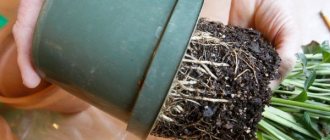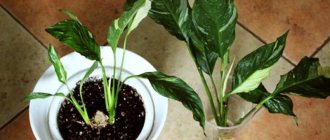The indoor violet, also known as uzambar violet, is a flowering herbaceous plant that came to windowsills from East Africa.
There, a delicate flower grows in mountainous areas near waterfalls and reproduces by self-sowing.
But in indoor conditions, propagation of violets will require the participation of a grower.
Reproduction at home
There are several simple ways to propagate violets, which have long been used by gardeners. They are simple and very effective, vegetative propagation methods are especially popular:
- cuttings;
- children;
- dividing the bush.
The choice of a specific technique depends on the time of year and age of the mother specimen, its varietal characteristics . However, if the goal is to obtain a large number of young specimens, they resort to the generative method - sowing seeds.
Violet propagation by stepsons
Stepchildren are new shoots, daughter rosettes that appear between the leaves of an adult violet. Usually they are simply removed so that they do not spoil the appearance of Saintpaulia. That is, they often appear on their own.
Stepchildren are very convenient to use for propagation, including chimera violets.
Chimera violets do not reproduce by leaf. More precisely, children will also grow from the chimera’s leaf, but they will not repeat the mother plant. To obtain a “clone” of such a violet, they resort to the following method: the top of an adult plant is cut off (then it is rooted), after which stepsons begin to grow on the lower part.
Note!
Chimera violets also reproduce by flower stalks. But not all. There are leaf chimeras for which propagation by stepsons is the only way to preserve varietal qualities.
With the appeared stepson, do the following:
- The stepson of the violet is grown until it has three or four pairs of leaves.
- Carefully separate the new shoot from the mother plant. For these purposes, use a toothpick or nail scissors.
- Place the stepson in the ground.
- Remove the pot for better rooting in the greenhouse.
- In a few months, the stepsons will become adult violets and bloom.
The process of propagation of violets by stepsons
Next is a video about the propagation of violets by stepsons:
General rules
To get healthy offspring, you should adhere to a number of important agrotechnical rules.
They concern not only the timing of reproduction, but also the creation of a favorable microclimate for the parent specimen and young violets . Therefore, in order to get an idea of how to propagate violets, you need to find out the main rules for caring for the plant.
What time of year is it best to propagate Saintpaulias?
Thanks to artificial lighting, cultivation of Saintpaulias is possible throughout the year.
But the optimal timing still occurs in spring and summer , when violets receive sufficient heat and light and are actively vegetating. In the fall, they are already preparing for a period of rest - rooting may not be successful.
Humidity level
Violet does well indoors. But the air should not be too dry. If the humidity is below 50-60%, it will be much more difficult to successfully propagate the flower.
Temperature
Intensive root formation occurs at a temperature of 26-28 °C. When the temperature drops below 20 °C, photosynthesis processes slow down, rooting occurs much more slowly, and the development of the vegetative mass is delayed.
Propagation of violets by peduncles
This method is used, as a rule, for chimera violets, which do not transmit their varietal characteristics when propagated by leaves.
The sequence for growing violets from a peduncle is as follows:
- Choose healthy peduncles with flowers of the correct varietal color. They are cut from the plant, flowers and buds are trimmed. Then the stem of the peduncle is shortened with a scalpel or blade, leaving 1-1.5 cm.
- Peduncles are rooted in soil or moss; the substrate must be filled to the level of the stipules.
- Over time, stipules develop stepchildren. They are raised and then separated like ordinary children.
- However, it is worth considering that this is an activity for the patient: many plantings die, and such reproduction takes time.
Propagation of violets by peduncles
The following video will tell you how to propagate violets using flower stalks:
Which plants to choose
Propagation material is taken from violets of any age. However, for a young mother specimen such a procedure will be painful, while for older specimens there is already a small supply of nutrients for successful rooting. It is better to choose plants aged 2-3 years.
If the bush is old with a powerful root system, it can be propagated by dividing the bush. In addition, such specimens may already have formed lateral rosettes, which are also suitable for producing new plants.
You should avoid using young Saintpaulias as a mother plant , giving them the opportunity to build up root and vegetative masses and accumulate maximum vitality.
What soil to choose for young Uzambara violet
For successful growth, violets require a light and loose soil mixture with excellent breathability. The best option is a substrate based on high-moor peat with the addition of perlite, vermiculite or polystyrene foam.
As an alternative, take sphagnum moss or peat tablets; violet roots also develop very well in them . Peat tablets must be soaked before use as indicated in the instructions.
Pot or glass? What is better and how to correctly determine the right size
To root cuttings or parts of the stem, use cups with a diameter of 5-6 cm. There should be drainage holes at the bottom to drain excess water. It is permissible to use plastic cups and yogurt containers, making holes in them yourself.
When dividing a bush, take a container with a slightly larger diameter than the root system of the planting material.
If you use a container that is too large, the soil that has not been developed by the roots will begin to sour, become compacted, and will no longer allow air to pass through to the underground part of the violet.
In what cases are greenhouses and moss needed?
To stimulate rooting, greenhouses are used, regardless of the chosen propagation method. Their installation makes it possible to create an optimal microclimate for the development of the root system of young flowers.
Moss also speeds up the root formation process by maintaining a high level of soil moisture . In this case, there is no danger that the soil mixture will sour.
Note! Not all varieties of violets reproduce in this way. For example, “Raisin” and “Chimera” violets may not retain their varietal characteristics. And the varieties of violets “Dance of Galaxies” and “Ice Rose” will most likely be preserved.
Do leaves always give roots?
No, sometimes they rot without ever taking root.
100%
Always, 100% of leaves give roots
0%
I constantly struggle with leaves, roots appear on 2-3 out of 10
0%
Voted: 4
Cutting leaf cuttings
Cuttings for propagation should only be taken from healthy Saintpaulias. The ideal leaf should be elastic, well developed, and have a natural color for the variety.
If the cutting is purchased, and you are not sure whether the plant was healthy, and also if the leaf blade has lost its elasticity during transportation, place the leaf for several hours in lukewarm boiled water with the addition of a few crystals of potassium permanganate. This will return the planting material to its original appearance and disinfect it.
In adult Saintpaulia, planting material is cut from the middle row of the rosette. Old leaves take root much worse. If you want to propagate a very young violet, on the contrary, you should take a cutting from the bottom row. To obtain varietal children, take a leaf directly from under the peduncle, which is currently blooming according to the variety.
The photo highlights one of the leaves that we will root.
The stem from the violet can be cut or broken off, and only then make an oblique cut with a sharp blade, knife or scissors. To obtain more children, you can additionally make a longitudinal incision, increasing the area for the formation of new roots.
There are many opinions on how long the cutting should be. Many people believe that it is better to leave only 3-4 cm of the stem. But practice shows that long cuttings take root just as well.
The good thing about a long stalk is that it can be used several times. After separating the children, roots will remain on the leaf. By placing such a cutting in water or planting it in the ground, you will get a new generation of violets faster than if you used a freshly cut leaf.
How to stimulate and speed up rooting
Two main techniques to speed up root formation still have the right to exist today. The first method involves the use of special drugs - growth stimulants . They are used to treat the cut site (in the case of propagation by leaf) or the roots of the division (in the case of propagation by dividing the bush).
The second way is to organize a mini-greenhouse . It is used as a film with a frame or a cut plastic bottle. Due to high humidity and temperature, root formation accelerates.
Recently, agrofibre has become popular; it can also be used to create a greenhouse environment. The canvas is much more durable than film, it is more durable.
How to choose a pot
Shallow pots are chosen for relocating Saintpaulias , since the roots of these flowers develop from the bottom up. A height of 10 cm and a diameter of 9 cm will be sufficient. If the plant is planted in a larger pot, it will intensively develop roots and entangle the earthen ball, and there will be no strength left for flowering.
A pot made of clay or plastic is suitable for violets . A clay pot provides good air permeability and maintains soil moisture at the roots. In such a pot, the plant is less likely to get sick and be attacked by pests. The downside of these pots is that they are heavy and not cheap.
A plastic flower pot is lightweight and easy to care for. Its disadvantage is poor air circulation. To fix this, holes are made with a nail in the bottom and side walls.
In this video they will show and tell you what pots and soil to plant violets in.
How to use cytokinin paste when propagating Saintpaulia
The product is used to produce babies from cuttings. The paste is applied with a needle into a scratch made on the petiole near the surface of the earth in a glass. Literally after 10-14 days, intensive formation of children begins , which must be placed in a timely manner.
How often to replant
In flowering perennials, the root system develops quickly . The plant quickly draws all the nutrients from the soil, and it becomes depleted. The roots begin to peek out of the drainage holes or above the ground. The violet needs to be replanted at least once every 7–8 months.
Timely transplantation of Saintpaulia into a new pot will help prevent diseases , and the violet itself will delight with beautiful flowering.
How to care for older children
Aftercare is quite simple. It comes down to simple steps:
- Watering - abundant moisture is required only for the first time. Then they make sure that the earthen ball does not dry out. The optimal method of watering is bottom (from a tray). The main thing is to prevent drops from getting on the leaves.
- Feeding - during the active growing season, feed with liquid complex fertilizers for flowering crops in half the dosage. Frequency of use: every decade.
- Protection from diseases and pests - violets have strong immunity. It is important not to over-moisten the soil, which can lead to the development of gray rot. The roots begin to rot, and over time the violet dies. Dry air is also dangerous, causing spider mites to colonize shoots. To combat the latter, insecticidal preparations are used.
- Transplantation - young plants are transplanted into slightly larger containers every spring to ensure lush flowering.
Is it possible to replant a blooming violet?
Replanting blooming violets is a common practice. With the most expensive and beautiful exhibition specimens there is no other way - they produce buds continuously for 10 months, and a new pot is needed every six months.
You just need to replant the bush during flowering using the transshipment method, without disturbing the earthen coma. Then there is no need to pick off the buds; Saintpaulia immediately resumes growth.
Peduncles are removed only when the substrate is replaced, for example, when the root rots.
It is better to replant the violet as soon as the need arises, rather than wait for it to stop putting out buds in the fall or winter. This culture chooses when to take a 2-month holiday at its own discretion, regardless of the season.
Often, especially in the southern regions, in the summer only a few corollas are open on a violet due to the heat. But in September the coolness comes and mass flowering begins, which continues throughout the winter.
Is it possible to grow Saintpaulias on a windowsill?
At home, violets are grown on windowsills. For the successful growth and development of young violets, it is enough to provide a good level of lighting: in winter, containers are placed near windows with a southern orientation, and in other periods - eastern or western .
To prevent young violets from being hot or cold, they are placed in mini-greenhouses where a stable temperature and humidity regime is maintained. The windows near the flower are not opened for ventilation to avoid drafts.
After successful rooting, the greenhouse is removed, and apartment conditions are suitable for adult plants (humidity - 50%, temperature - 22 °C).
Spots on violet leaves: what to do?
Spots on violet leaves
Beginning flower growers, seeing spots on violet leaves, are immediately upset as they think that they are a harbinger of the death of the flower. In fact, in this way it can react to changes in the environment. For example, if a flower evaporates more moisture than it receives, then its leaves become covered with brownish spots.
Yellow spots indicate that the plant has received sunburn and urgently needs to be removed from the sun's rays. Watery, white lesions appear with excessive watering or sudden temperature changes. I would like to say right away that there is no need to treat the affected leaves; if you want the plant to improve its health, simply remove them and coat the cut areas with crushed activated carbon.
What methods to use for varietal Saintpaulias
The seed propagation method is not only a labor-intensive process: even after successful artificial pollination, the formation of seed pods and the collection of seed material, the method will not give the expected results when growing varietal flowers. The resulting seedlings do not retain the varietal characteristics of the parent specimen.
This can be avoided by using vegetative techniques. Any method is suitable, from cuttings, propagation by rosettes and to dividing the bush. The exception is the chimera violet. In this case, the apical propagation method is used.
Propagation of violets by leaf fragments
It happens that the leg of the leaf breaks off or the leaf plate itself begins to deteriorate. It doesn’t matter – you can grow a violet even from a small part of a leaf.
To do this, you need to cut the sheet correctly. Be sure to remove all rotting and damaged parts to healthy tissue, using a knife with a disinfected sharp blade. All cut lines must pass between the lateral veins without damaging them. Since the lateral veins will subsequently produce children.
There are the following methods for obtaining leaf fragments:
- The sheet is cut crosswise. In this case, 4 fragments are obtained: lower, upper and two side ones. If you need to increase the amount of planting material, you can divide these fragments into even smaller parts. The main thing is that in each of them at least one side vein is intact.
- The method is used in the absence of a petiole. Then an artificial petiole approximately 1 cm long is cut out from the central vein of the leaf plate. It is planted in soil or moss, just as when planting a regular Saintpaulia leaf cutting.
- If the leaf does not have a petiole, then you can plant it in its original form, without bothering with cutting anything out. They simply bury the bottom of the leaf into the ground and wait for the babies. You can also plant the cut off upper or lower halves of the leaf.
- The leaf is cut in a circle to save space in the greenhouse or to remove rotten edges.
The resulting leaf fragments are buried with the lower edge into the soil or moss. And they put the pots in the greenhouse.
This is how full-fledged children grow from fragments of a violet leaf
How to cut a leaf to obtain fragments and how to plant these fragments in the ground - all this is explained in the video:
Advice from experienced flower growers
Propagation of violets is a painstaking but fascinating process. If you follow all the rules, the florist can easily preserve the varietal qualities, receiving many young, lushly blooming violets.
Are you looking for an answer to the question why violets don’t bloom? Perhaps they are affected by some kind of disease or pests are bothering them.
Choosing a leaf for rooting
To propagate violets with a leaf, it is better to choose the one located under the flower arrow. They are considered more suitable for germination. In addition to this rule, there are several more conditions that it is advisable to observe when selecting leaf cuttings:
- It is worth considering that any Saintpaulia leaf on a bush has a lifespan of about 1 year and then dies. For propagation, it is better not to take outdated leaves from the bottom of the bush. You can get high-quality seedlings from strong, well-developed cuttings from the middle of the plant.
- Flower growers believe that a leaf blade that is too large does not indicate the quality of the cutting. Most of the daughter rosettes appear on the cut of the leaf with the middle blade.
- The leaf stalk should have good turgor and a thick petiole.
- You can’t take limp, spotted, rotting leaves for propagation. Planting material must be completely healthy, without visible signs of disease.
How to cut correctly?
You can cut a leaf from a bush at will, trying to get the longest petiole. But before you root the violet leaf, you need to make the right cut to get as many seedlings as possible.
The cut is made with a sterile sharp instrument (razor blade, stationery knife, scalpel). This allows you to avoid crushing the succulent tissues of the cutting, and it gives roots faster. The cut is best made at an angle of 45° to the main axis of the leaf petiole (pedicle). After this, it is allowed to air for 30 minutes, and when rooted in the ground, it is dipped in ground charcoal or activated carbon.
What soil to plant violets in
To independently prepare soil that is best suited for violets , you will need the following components in equal parts:
- two parts of leaf soil;
- part of coniferous soil;
- part of the peat;
- part of the turf land;
- some river sand;
- a handful of charcoal.
Advice! For better results, vermicompost can be added to the soil 2 weeks before transplanting.
The prepared substrate must be disinfected. To do this, it is steamed in the oven or doused with boiling water. After the soil has cooled, you can begin replanting the Saintpaulias.
Peculiarities
Indoor flowers, especially blooming ones, please the eye, decorate homes and offices, and purify the air. However, it is very difficult to maintain some types of plants because of their whimsical nature. So is the violet, which is not particularly demanding in terms of living conditions, but also has its own disadvantages in growing.
Advantages:
- low maintenance, except for lighting and watering;
- do not cause allergic reactions, are not poisonous;
- have the unique property of purifying indoor air during the daytime;
- amazing and varied beauty of flowering;
- has the property of driving away ants; in a house where there are violets, ants will never appear.
Flaws:
- at night the plant releases carbon dioxide, which forces the owners to take it away from the sleeping place;
- when flowering, it emits an aroma that can cause headaches in overly sensitive people;
- poisonous to domestic animals, particularly cats.
Having analyzed all the advantages and disadvantages of growing violets, we can conclude whether it is worth rooting a plant from a leaf at home in order to decorate your home in the future with bright blooms. From a biological point of view, violets should be kept away from the sleeping place or taken out of the room each time. From an objective point of view, the plant is quite unpretentious, blooms beautifully, amazes with its long flowering, is absolutely non-toxic and not poisonous to people. Moreover, a huge selection of varieties of blooming violets brings pleasure to any gardener.
Possible problems and their solutions
When rooting Saintpaulia cuttings, you may encounter the following problems:
- the violet leaf rots - remove the stalk, cut it to living tissue and dip the cut in Kornevin. Pour warm water into a clean bowl, dissolve 1/3 of an activated carbon tablet in it and lower the handle so that the cut does not touch the dish;
- the rooted violet leaf has lost its turgor - you should cover it and keep it in a greenhouse for some time until the turgor is restored;
- the rooted leaf has broken - continue to care for the “stump” as before. There is a high percentage that children will still appear. And although they will be weaker, time and care will correct the situation. A piece of leaf can be left for rooting;
- the rooted leaf has turned black - this can happen for two reasons: excess moisture and sunburn. If the leaf can still be saved, remove it from the window and open the greenhouse. If possible, cut off the rot to healthy tissue. If you couldn’t save the sheet, analyze your mistakes for the future.
IMPORTANT! The diameter of the container for cutting should not exceed 50 mm!
Care Tips
- never place Saintpaulias in direct sunlight;
- in the case of violets, it is better to “underwater than overwater”;
- babies can be separated from the mother leaf when their growth has reached 1/3 of the plate;
- To prevent flowers from stretching out in winter, they need additional lighting;
- Every 3 years the plant needs to be renewed.
If something doesn’t work out, don’t give up on floriculture, try it, and everything will definitely work out!
Information for beginning gardeners
When propagating violets with leaves, beginning gardeners most often have the following questions:
- use of Kornevin: to root the cuttings, you can use a solution of the drug - a pinch per ½ liter of water. The same solution can be watered on a plant planted in the ground. You can also dust the cut of the cutting with Kornevin powder, but some delicate varieties of violets can get a chemical burn;
- the leaf has taken root, but there are no children: perhaps the children cannot overcome the thickness of the soil and they need help. Another option is to stress the cuttings: take them out of the greenhouse and cut off 1/3 of the leaves, most often this helps;
- rooting Saintpaulia cuttings in winter : experienced gardeners root violets all year round. If the window sill is cold in winter, you can simply put foam on it. Cuttings planted using technology will produce new plants both in autumn and winter.
Rooting with a tablet
How to breed violets from leaves using peat tablets? This method is incredibly simple. With its help, you can root the petiole without additional manipulation. In addition, there is no need to form a drainage layer. The tablet already contains the necessary fertilizers and growth stimulants. This allows you to speed up the rooting of the cuttings. The tablet is very convenient to use. After the cutting is rooted, it is planted in the ground along with the plant without disturbing the roots.
The peat tablet is initially hard and flat. Before rooting, remove it from the package and soak it in liquid for 15 minutes. As a result, it increases in height five times. Drain off excess water. And we plant the cutting directly into the tablet, deepening the fresh cut by a centimeter. Then we place everything together in a glass, covering it with something transparent on top. The container should be slightly taller and wider than the tablet. After the leaf has rooted, we transplant the young plant along with peat into a pot.
Typical germination mistakes
Negative results often occur during the first attempts to breed Saintpaulia. Reasons for failure:
- Leaf rotting. Most often it happens due to waterlogging, especially in winter. To speed up rooting, the cut is dipped in root material before being immersed in the soil.
- Water in rooting cups is disinfected with activated carbon.
- The rooted leaf became limp. You should place it in a greenhouse and reduce watering for a while.
- The leaf turned black. This happens due to excess moisture and sunburn. The pot should be placed in a greenhouse away from direct sun and dried.
Note! The general rule is: it’s better to dry it out a little than to fill it with soil. When rooting in water, you should change it to clean water every day and wash the glass.
Transplanting violets after germination
As soon as the rosettes of the children have formed, they are carefully separated and transplanted into new containers. The optimal time is autumn (September-October). Winter is the most inappropriate period. The next time the pot will be changed will be in the spring (February-March).
How to determine whether a plant is ready for transplanting
The signal for replanting is the filling of the pot with roots, as well as a white coating on the surface of the soil - mineral sediment. If the roots prop up the walls of the pot and peek out from the lower drainage holes, this is an already advanced case and replanting is required urgently. The goal is to change the soil to a new one rich in nutrients. New roots grow from the part of the stem that is above the soil. Therefore, the plant is freed from old lower leaves (if necessary), and the stem is slightly buried.
Children are separated from each other
Note! You can leave the pot the same. When increasing the capacity, flowering will not occur until the violet has mastered the new volume.
How to choose and prepare soil for planting
The soil is suitable with acidity pH=5.5-6.5. When choosing a ready-made substrate in a store, preference is given not to black, but to brown soil, rich in coarse-fibered high-moor peat. Various leavening agents are mixed into it by a third of the volume: sand, charcoal, vermiculite, coconut fiber, perlite, sphagnum moss.
Humidity, temperature, lighting
After waiting until the soil dries, remove the violet from the old pot and carefully shake off the old soil. Long, old and rotten roots are removed. Pinch off the bottom row of leaves if they look unattractive, given that this will delay flowering for at least a month.
The first two days after transplantation, watering is not carried out to give time to the root injuries. The pot is placed in a warm place (23-25 °C). If the air is very dry (humidity 50% or less), then use a greenhouse.
Important! Lighting is required for 12 hours, so if the daylight hours are too short, it is advisable to organize additional lighting.
Characteristic
The ancient Greeks tried to root violets from leaves. This flower was special for them; they worshiped it, considering it a symbol of eternal love and fertility. The petals of the plant were added to wines, dishes and love potions were prepared from them. Despite its idealistic vocation, in our time violets are grown to decorate living spaces, and many believe that the flower attracts love and prosperity into the home.
Description of the plant:
- Violet is a perennial houseplant belonging to the violet family.
- The flower grows small in size - from 15 to 40 cm.
- All varieties of violets have the same structure of the root system - tree-like, juicy, dense structure.
- The stems are shortened, and due to slow growth, the leaves of the flower form very tightly to each other, forming rosettes.
- Radical green mass and flower stalks begin to form in the spring during the period of active photosynthesis. At the beginning of spring, the flower can already please its owners with the first buds.
- The flowering is single, consisting of five petals, which are lanceolate and ovoid in shape.
- Violet leaves are whole, round in shape, with heart-shaped or oval contours, with notches along the edges.
- The leaves may have a smooth or velvety surface. The latter are found in most varieties.
- Active flowering begins in early spring and continues continuously until mid-autumn.
- After flowering, the beautiful inflorescences form seed pods. These boxes are oblong or oval in shape and smooth to the touch.
Violet has not only aesthetic properties, but also medicinal ones. The inflorescences, leaves and stems of the plant are used to make medicines that are used for various inflammatory processes and as antiseptics. The plant also helps greatly with kidney diseases, gastrointestinal tract and respiratory infections.
The therapeutic effect of violets is due to the content of the following substances:
- carotene;
- vitamin C;
- salicylic acid;
- glycosides.
Despite its rich medicinal composition and effectiveness in treating various diseases, the use of violet for hepatitis and glomerulonephritis is contraindicated. Excessive dosages and prolonged use of such medications are also dangerous, as this can lead to nausea, vomiting, and diarrhea. About 30 species of violets are grown in home floriculture, and there are about 600 species in the world. Scientists divide them into 16 genera, of which there are wild violets, forest violets, garden violets and indoor violets.
The most common types of violets grown indoors are:
| Type of violet | Description |
| Kimi's melodies | The leaf blades are wavy, folded into a symmetrical rosette. The inflorescences are white with two upper petals of blue. |
| The magic of love | The inflorescences are large, double, the petals resemble stars. Painted burgundy with a rich red tint and white trim. The foliage is deep green. |
| Black Prince | The inflorescences are distinguished by their unusual beauty. The petals are double, star-shaped, dark red. Leaf rosettes are medium in size, deep green in color with a red tint on the reverse side. |
| Admiral | The peculiarity of the variety is that the inflorescences are fused at the base of the petals, which makes them similar to bells. The Admiral has large flowers with a cornflower blue color, semi-double petals with wavy edges. The foliage has a pointed shape, deep green with a lilac-cream edge. |
| Shining bell | Blue flowers with wavy edges. In the center of the inflorescence there is a contrasting yellow eye. The leaf rosette has the correct shape, the foliage is of a uniform green color. |
| Satellite | A medium-sized leaf rosette (up to 15 cm), with light green leaves reaching 5 cm in length. The inflorescences are red-violet in color. |











